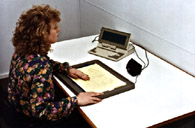
Nomad computer interface
1990
interface for people with impaired vision
Nomad is a computer interface that enables vision impaired people to read maps and plans and to make sense of what they draw.
A 'tactile' graphic with raised features is placed on the Nomad touch-sensitive pad, which has a built-in speech synthesiser. The Nomad is connected to a computer so that information about any point on the graphic can be entered when the point is pressed against the pad. In this way, the graphic can be quickly annotated for use by a vision-imparied person.
Once this is done, users can place the same raised graphic on the Nomad pad at any time and call up the relevant computer file. When they press any point of interest (for example, a street intersection or landform on a map), they can hear the information for that point played by the speech synthesiser.
In this way Nomad gives vision impaired people greater access to subjects which use a lot of diagrams and pictures, like geography, biology and geometry. There are countless other uses such as in shopping centre or university directories.
The idea for Nomad came to Professor Don Parkes of Newcastle University when his colleague Reg Golledge, a Professor of Geography from California, suddenly became blind. Nomad is named after Golledge's guide dog.
Parkes' prototype was commercialised by Quantum Technology Pty Ltd as part of its range of electronic products for vision impaired people and is now sold worldwide.
Who Did It?
Key Organisations
Quantum Technology Pty Ltd : design, manufacture
Institute of Behavioural Science : R&D
Key People
Don Parkes : inventor
Further Reading
'Technology helping the blind'
Monique Forner
The Sydney Morning Herald, 6 July 1992.
Links
Quantum Technology
Royal Blind Society
The Low Vision Gateway
Related Innovations
Mountbatten Brailler
|










